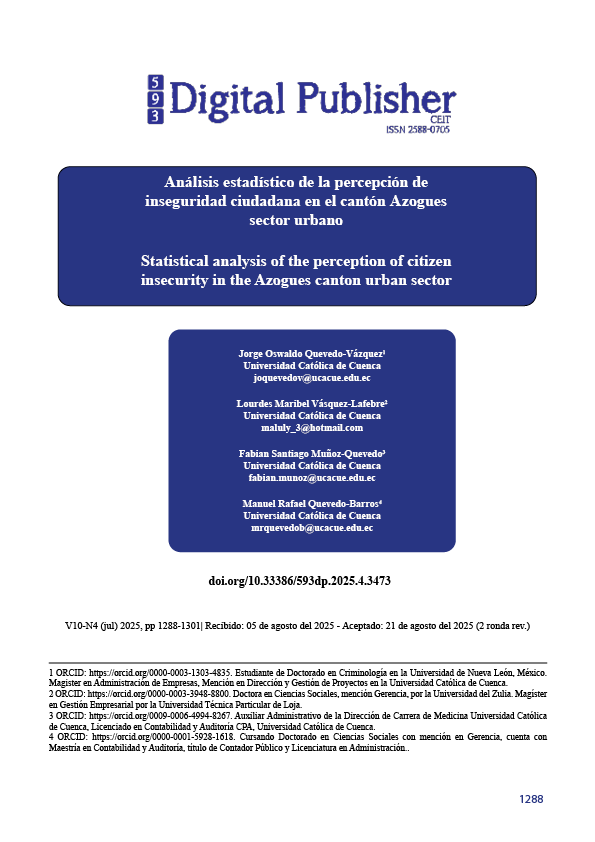Statistical analysis of the perception of citizen insecurity in the Azogues canton urban sector
Main Article Content
Abstract
It's not always necessary to have been the victim of a crime to begin to feel fear. Sometimes, just looking around or simply noticing certain changes in the environment is enough to trigger a feeling of insecurity. In Azogues, where close relationships between people are still preserved, this type of fear rarely appears in official records, but it can be seen in everyday decisions: streets avoided, schedules changed. This research was conceived with the aim of understanding how insecurity is experienced and perceived in urban settings, focusing on factors such as age, gender, education, and place of residence. A mixed-method approach was used, combining a review of previous studies with a survey of 384 people, selected using stratified sampling to ensure adequate representation. The data collection instrument was evaluated by experts and obtained a high degree of reliability (α = 0.859), which allows for the certainty of the results obtained. The findings reveal that women, older adults, those with lower educational levels, and those living in disadvantaged areas experience higher levels of insecurity. This demonstrates that fear does not always respond to concrete facts, but rather is constructed from an emotional perspective. The research revolves around a key question: how does the perception of insecurity in Azogues vary by age, gender, educational level, and area of residence?
Downloads
Article Details

This work is licensed under a Creative Commons Attribution-NonCommercial-ShareAlike 4.0 International License.
1. Derechos de autor
Las obras que se publican en 593 Digital Publisher CEIT están sujetas a los siguientes términos:
1.1. 593 Digital Publisher CEIT, conserva los derechos patrimoniales (copyright) de las obras publicadas, favorece y permite la reutilización de las mismas bajo la licencia Licencia Creative Commons 4.0 de Reconocimiento-NoComercial-CompartirIgual 4.0, por lo cual se pueden copiar, usar, difundir, transmitir y exponer públicamente, siempre que:
1.1.a. Se cite la autoría y fuente original de su publicación (revista, editorial, URL).
1.1.b. No se usen para fines comerciales u onerosos.
1.1.c. Se mencione la existencia y especificaciones de esta licencia de uso.
References
Argibay, J. C. (2006). Técnicas psicométricas. Cuestiones de validez y confiabilidad.
Coronel. S. (2024). Los factores socio-espaciales que inciden en la percepción de seguridad de los jóvenes en el espacio público.
Darren. G, & Mallery. P. (2024). IBM SPSS Statistics 29 Step by Step. : : 978-1-032-62212-5.
Dos Santos. J, Barrios., E., Creamer., E., & Onwuegbuzie., A. (2020). Mixed methods research in Latin America: Initiatives and opportunities for expansion. In Texto e Contexto Enfermagem (Vol. 29, pp. 1–3). Universidade Federal de Santa Catarina. https://doi.org/10.1590/1980-265X-TCE-2020-0001-0001
Guevara Torres, R. J., Romero Granda, L. D., & Salcedo-Muñoz, V. E. (2025). Índice de prosperidad urbana: percepción de la variable seguridad en el cantón Santa Rosa – Ecuador. Mujer Andina, 3(2), 15–30. https://doi.org/10.36881/ma.v3i2.1012
Gutiérrez. M., Dorantes. A., Garces. I., Martínez. K., Serafin. M., & Nava. E. (2025). Percepción de Seguridad en el AGEB 013-7 y su Impacto en el Acceso a la Salud. Ciencia y Reflexión, 4(1), 581–604. https://doi.org/10.70747/cr.v4i1.130
Jerves, S. P., & Palacios, C. H. (2021a). Quality of the Urban environment and the perception of safety for women comparison between two neighborhoods in Cuenca, Ecuador. Urbano, 24(44), 34–45. https://doi.org/10.22320/07183607.2021.24.44.03
Jerves, S. P., & Palacios, C. H. (2021b). Quality of the Urban Environment and the perception of safety for women comparison between two neighborhoods in Cuenca, Ecuador. Urbano, 24(44), 34–45. https://doi.org/10.22320/07183607.2021.24.44.03
Kelling, G., & Wilson. J. (2024). Broken Windows The police and neighborhood safety. Atlantic Monthly, 249(3), 29–38. http://www.theatlantic.com/magazine/archive/1982/03/broken-windows/304465/1
Lawshe, C. H. (1975). A quantitative approach to content valitity (Vol. 28).
León. A, Díaz. S, & Márquez. L. (2023). Analysis of the perception of insecurity with a gender approach in the choice of public transport. Case study Tunja, Colombia. Eure, 49(147). https://doi.org/10.7764/eure.49.147.02
Morocho. P, & Romero. M. (2024). Violencia de género y factores asociados en los estudiantes de la Facultad de Ciencias Médicas de la Universidad de Cuenca. 2023-2024. Universidad de Cuencua.
Oviedo. H, & Campo. A. (2005). Metodología de investigación y lectura crítica de estudios Aproximación al uso del coeficiente alfa de Cronbach Title: An Approach to the Use of Cronbach’s Alfa.
Pluma. D. (2024). Confianza institucional y percepción de inseguridad en América Latina. Revista Latinoamericana de Seguridad Ciudadana. Universidad Autónoma del Estado de Hidalgo.
Ramos. L. (2025). La inseguridad en México. Un debate entre la realidad y la percepción. Perfiles de Las Ciencias Sociales, 12(24). https://doi.org/10.19136/pcs.a12n24.6604
Ramos. L. (2025). La inseguridad en México. Un debate entre la realidad y la percepción. Perfiles de Las Ciencias Sociales, 12(24). https://doi.org/10.19136/pcs.a12n24.6604
Razeto. A. (2016). Confianza interpersonal entre los miembros de una escuela: valor básico y olvidado por las reformas educativas. Actualidades Investigativas En Educación, 16(1). https://doi.org/10.15517/aie.v16i1.21926
Robledo, M. S. (2023). Indicadores de programas de políticas públicas: una revisión del programa Ciudades Seguras en Quito. Mundos Plurales - Revista Latinoamericana de Políticas y Acción Pública, 10(2), 71–82. https://doi.org/10.17141/mundosplurales.2.2023.6000
Tapia. J. (2024). Inseguridad en Quevedo, Ecuador: percepciones, influencias y repercusiones en la cotidianidad.
Torres. J. (2023). Redes interafectivas en Bogotá (Colombia): ¿personas habitantes de calle objetos o sujetos de miedo? 1852-8759., 40–56. www.relaces.com.ar
Triana. J. (2021). Percepción de inseguridad, temor al delito y medidas de autoprotección: el caso de Acapulco, Guerrero. Nóesis. Revista de Ciencias Sociales y Humanidades, 30(60), 166–190. https://doi.org/10.20983/noesis.2021.2.9
Triana Sánchez, J. L. (2021). Percepción de inseguridad, temor al delito y medidas de autoprotección: el caso de Acapulco, Guerrero. Nóesis. Revista de Ciencias Sociales y Humanidades, 30(60), 166–190. https://doi.org/10.20983/noesis.2021.2.9
Valencia. P., Nateras. M., & Pacheco. M. (2023). Gender Factors of Objective and Subjective Insecurity: The Cases of Mexico and Colombia. In Polít. Crim (Vol. 18, Issue 13).





